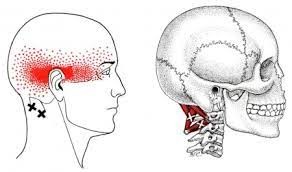Headaches? Give Chiropractic a Chance!
A Complicated Condition
One of the most debilitating complaints we will see in our office is headaches. This can either be from the intensity, duration, or both. The location can also be variable from person to person, with correlating jaw or neck pain not uncommon. We usually see a combination of these complaints as compounding factors that overlap each other, with each one needing to be addressed to help the patient best.
What is frustrating, from a chiropractor’s standpoint of headache complaints, are how they are misdiagnosed by other providers. We regularly see patients spending an abhorrent amount of money on out of pocket tests, neurologist visits, imaging, treatment (botox, medication), etc. for something that is simply musculoskeletal tension. Often times, they still end up in our office because they have had little relief.
Trigger Points
Luckily, musculoskeletal pain is our forte. Most headache complaint patients tend to have built up muscular tension in the form of what we call trigger points. What’s important about trigger points is that each muscle has a specific distribution pattern of where the symptoms are elicited. Additionally, it is worth noting that where the muscle is located is usually NOT where the headache or pain are felt by the patient. For example, you can tell from the above picture, that depending on where the patient has their headache symptoms, a specific muscle is at fault/needs to be addressed, in conjunction with whatever other findings the provider discovers.
Treatment
The reason why trigger points occur can be complicated and multi-factorial, however, we find the various modalities we use in our office help address the majority of these. From dry needling, IASTM, and myofascial release to spinal manipulative therapy (adjusting), these muscles “reset” to their baseline, and release the tension over the course of treatment. It is actually common for patients who present with headache symptoms to leave without one (or at least much improved), to see a decrease in the amount they’re having during the week and/or headache severity improving with each visit as well.
In the very few cases that headache patients don’t improve, we often refer them to get some lab work with a functional medicine provider who we trust and work with. If releasing the tension and addressing the trigger points do not get the results we are looking for, there can be something going on internally such as hormonal imbalance, food sensitivities, etc. that may need to be addressed. These patients find great relief from continuing to address the musculoskeletal aspect of care while simultaneously working with our functional medicine colleagues.
Conclusion
We empathize with patients who have acute or chronic headaches. Before wasting a lot of time and resources on other treatments with sparing results, give chiropractic care a chance to address your headaches for good. Although every patient and background is different, it is not uncommon to help patients and have improvement in their headache or other pain in eight visits, while continuing to work on other rehab to decrease future flare-ups or issues.
About the author
Dr. Sam Reals’ empathy for people in pain motivates him to learn the most up-to-date treatment standards and rehab protocols, encouraging patients to incorporate exercise long after their care plan has concluded. Dr. Sam Reals believes it is only through exercise that people can unlock their true potential and increase longevity to a happy, fulfilling life.
